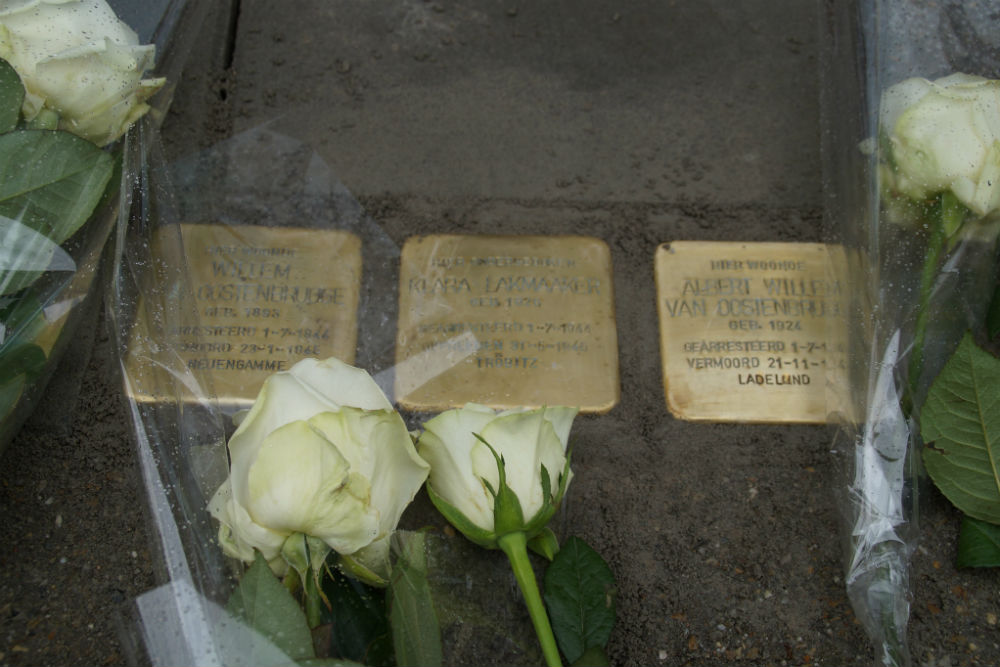Stumbling Stones Lijnbaanstraat 4 (formerly Tuinstraat 204a)
These small, brass memorial plaques (Stolpersteine, struikelstenen, or stumbling stones) commemorate:
* Willem van Oostenbrugge, born 1893, arrested 1 July 1944, murdered 23 January 1945, Neuengamme.
* Klara Lakmaaker, born 1926, arrested 1 July 1944, died 31 May 1945, Tröbitz.
* Albert Willem van Oostenbrugge, born 1924, arrested 1 July 1944, murdered 21 November 1944, Ladelund.
At this location (formerly Tuinstraat 204a), Willem van Oostenbrugge and his son Albert Willem gave refuge to Klara Lakmaaker. (Klara in 1941 had been living with her parents and sister in Amsterdam.)
Eventually, Klara and the van Oostenbrugges were denounced and picked up by local police on 1 July 1944 (or 1 June 1944). The two men were taken to Amersfoort and then Neuengamme. Albert was next sent to the satellite Camp Ladelund, where the work was digging anti-tank trenches in freezing weather. Albert refused to work for the SS. Neither father nor son survived.
In Isselmuiden, Klara was quickly picked up from the police lockup by the Germans and sent first to Westerbork, then to Bergen-Belsen. Just one or two days before the liberation of Bergen-Belsen, she and about 2,500 others were put on a train which went from place to place in Germany apparently randomly due to damage to the rail lines. This was called the "lost train," which could not find a place to get rid of the human evidence from Bergen-Belsen. When the Russians liberated the train on 23 April near Tröbitz, many of the surviving passengers were seriously ill, including typhus. A witness said Klara Lakmaaker died on 15 May 1945.
"Stolpersteine" is an art project for Europe by Gunter Demnig to commemorate victims of National Socialism (Nazism). Stolpersteine (stumbling stones) are small, 10x10cm brass plaques placed in the pavement in front of the last voluntary residence of (mostly Jewish) victims who were murdered by the Nazis. Each plaque is engraved with the victim’s name, date of birth, and place (mostly a concentration camp) and date of death. By doing this, Gunter Demnig gives an individual memorial to each victim. One stone, one name, one person. He cites the Talmud: "A human being is forgotten only when his or her name is forgotten."
Borne was the first town in the Netherlands in which Stolpersteine were placed -- on 29 November 2007.
Do you have more information about this location? Inform us!
Source
Nearby
Museum
Point of interest
Monument
- War Memorial IJsselmuiden - IJsselmuiden
- Jewish Memorial Kampen - Kampen
- Memorials Executions - Kampen
Cemetery
- Dutch War Graves Roman Catholic Cemetery IJsselmuiden - IJsselmuiden
- Commonwealth War Graves IJsselmuiden - IJsselmuiden
- Dutch War Graves IJsselmuiden - IJsselmuiden
Remembrance Stone
- Stumbling Stone Oudestraat 133 - Kampen
- Stumbling Stones Oudestraat 39 - Kampen
- Stumbling Stones Oudestraat 114 - Kampen





